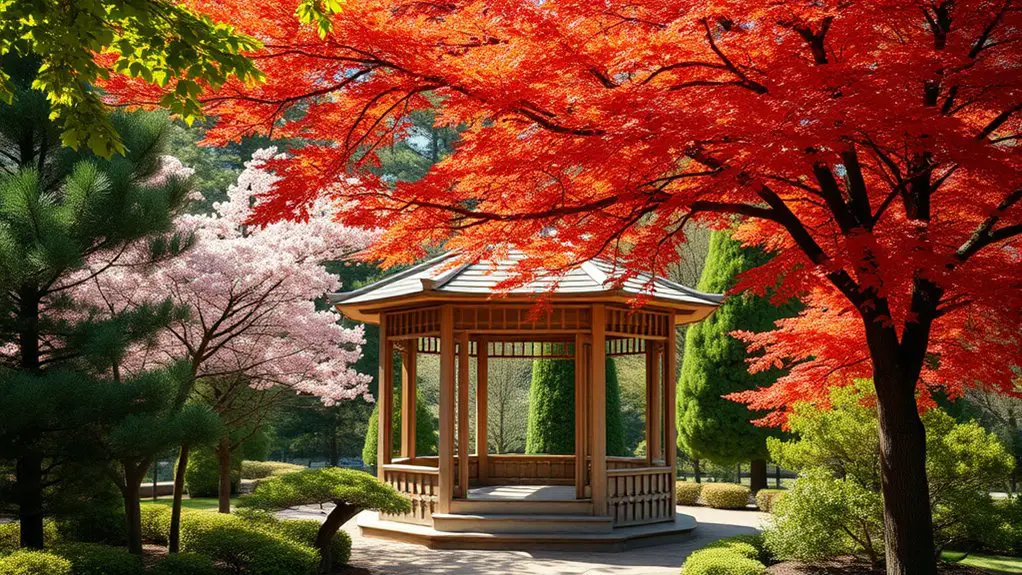When choosing trees for your gazebo, consider the stunning Flowering Dogwood and the elegant Japanese Maple for their vibrant blooms and foliage. The Red Maple offers brilliant fall colors while the Eastern Redbud attracts pollinators with its early spring blossoms. Weeping Cherry creates an enchanting atmosphere with its cascading branches, while Magnolias and Crape Myrtles provide diverse textures and colors. Planting Olive Trees can add Mediterranean elegance. There’s so much more to explore about each tree’s unique benefits.
Flowering Dogwood
The Flowering Dogwood, with its stunning pink or white blooms, is a popular choice for enhancing the beauty around your gazebo. This tree not only provides aesthetic appeal but also invites a sense of tranquility and freedom to your outdoor space. When considering flowering dogwood care, make sure it’s planted in well-drained soil and receives partial shade to thrive. Regular watering during dry spells promotes healthy growth, while mulching can help retain moisture.
There are several flowering dogwood varieties to choose from, such as Cornus florida, known for its classic blossoms, or the more disease-resistant Cornus kousa, which offers unique star-shaped flowers. Each variety brings its own charm, allowing you to customize your gazebo’s landscape. By selecting the right type and providing proper care, you’ll create an inviting atmosphere that celebrates nature’s beauty.
Japanese Maple
The Japanese Maple stands out with its stunning foliage colors, ranging from vibrant reds to deep purples, creating a visual feast around your gazebo. Its elegant canopy provides ideal shade, enhancing your outdoor experience while maintaining an inviting atmosphere. Additionally, its manageable size and moderate growth rate make it a perfect choice for creating a serene retreat without overwhelming your space.
Stunning Foliage Colors
Japanese Maple is renowned for its breathtaking foliage, showcasing a stunning array of colors throughout the seasons. In spring, you’ll witness delicate green leaves unfurling, evolving to a rich palette of vibrant colors in summer. As fall approaches, the Japanese Maple truly dazzles, presenting a magnificent display of fall foliage in hues of fiery red, deep orange, and golden yellow. This vibrant transformation creates a picturesque backdrop for your gazebo, inviting you to embrace nature’s artistry. The contrast of these striking colors against the soft lines of your structure enhances the overall aesthetic, making every moment spent outdoors feel enchanting. With such alluring foliage, you’ll find yourself drawn to the serenity and beauty this tree brings to your landscape.
Ideal Shade Provider
With its exquisite foliage, this tree not only captivates the eye but also serves as an ideal shade provider for your gazebo. The Japanese Maple, with its delicately dissected leaves, offers significant shade benefits, creating a serene retreat from the sun’s harsh rays. Its vibrant colors transform with the seasons, adding aesthetic value while enhancing your outdoor experience. As it matures, it casts a gentle canopy that provides cooling effects during hot summer days, allowing you to enjoy your gazebo comfortably. The dappled light filtering through the leaves creates an enchanting atmosphere, perfect for relaxation or gatherings. If you seek a graceful tree that combines beauty and shade, the Japanese Maple is an excellent choice for your outdoor sanctuary.
Size and Growth Rate
Although you may envision a grand tree towering over your gazebo, the Japanese Maple typically reaches a manageable height of 10 to 25 feet, making it suitable for smaller spaces. Its elegant, cascading branches and vibrant foliage create a stunning backdrop without overwhelming your area. The growth habits of this tree are slow to moderate, allowing you to enjoy its beauty without the worry of rapid expansion. With minimal maintenance requirements, such as occasional pruning to maintain shape, it’s perfect for those seeking a low-effort yet aesthetic addition to their landscape. Choose from various cultivars to find the one that best complements your gazebo, enhancing your outdoor space with color and grace while preserving the serene atmosphere you desire.
Red Maple
The Red Maple, renowned for its stunning fall foliage, is an excellent choice for planting around your gazebo. With its vibrant red leaves transforming your outdoor space, it not only enhances aesthetics but also provides several red maple benefits. These trees are known for their adaptability, making them ideal for various soil types and climates.
Here are three key aspects of red maple care to guarantee your tree thrives:
- Watering: Regularly water your Red Maple, especially during dry spells, to maintain healthy growth.
- Sunlight: Plant it in a location that receives full sun to partial shade, maximizing its vibrant color and leaf development.
- Pruning: Prune during late winter to encourage a strong structure and remove any dead or diseased branches.
Eastern Redbud
Eastern Redbud, a stunning ornamental tree, brings a burst of color to your gazebo area with its vibrant pink to purple blossoms in early spring. This native beauty not only enhances your landscape but also attracts pollinators, making it a favorite among gardeners. The eastern redbud benefits include its heart-shaped leaves that turn a lovely yellow in fall, adding seasonal interest.
When considering eastern redbud care, you’ll find it easy to maintain. It thrives in well-drained soil and prefers full sun to partial shade, allowing you to position it where it complements your gazebo perfectly. Regular watering during dry spells will keep it healthy, while minimal pruning in late winter helps maintain its shape.
With its striking appearance and manageable requirements, the eastern redbud encourages a sense of freedom in your garden, inviting you to relax and enjoy the beauty of nature right from your gazebo.
Weeping Cherry
The Weeping Cherry tree enchants with its stunning seasonal blooms, creating a breathtaking spectacle in spring. Its graceful weeping form adds a touch of elegance to your gazebo’s surroundings, offering a picturesque backdrop for relaxation. Additionally, this tree provides ideal shade, making it a perfect companion for outdoor gatherings.
Stunning Seasonal Blooms
While you might envision a serene retreat around your gazebo, the addition of a Weeping Cherry can transform that vision into a breathtaking reality. This tree’s stunning seasonal blooms create a spectacle that captivates the senses. The delicate pink blossoms emerge during its bloom cycle, offering vibrant seasonal color that enhances your outdoor space.
Here are three reasons to contemplate a Weeping Cherry:
- Aesthetic Appeal: Its cascading branches adorned with flowers create an enchanting atmosphere.
- Pollinator Friendly: The blooms attract bees and butterflies, fostering a lively ecosystem.
- Seasonal Interest: Enjoy a dynamic display, as the tree shifts from spring’s blossoms to summer greenery and autumn’s warm hues.
Incorporating a Weeping Cherry can elevate your gazebo experience considerably.
Graceful Weeping Form
Drawing the eye with its elegant silhouette, the Weeping Cherry showcases a graceful weeping form that adds a unique structural element to any landscape. Its cascading branches create a serene atmosphere, inviting you to linger beneath its delicate canopy. The soft pink blooms in spring contrast beautifully with the rich green foliage, making it an ornamental marvel. Like the weeping willow, the Weeping Cherry exudes a sense of tranquility, while also offering a more compact size, perfect for smaller gardens. Pairing it with ornamental plum trees can enhance the visual appeal, as their contrasting forms and colors create a harmonious composition. This tree not only decorates your gazebo but also elevates your outdoor experience, embodying freedom and beauty.
Ideal for Shade
When seeking a tree that not only enhances your gazebo’s aesthetic but also provides ample shade, the Weeping Cherry stands out as an exceptional choice. Its cascading branches create a natural canopy, offering significant shade benefits for those warm afternoons. By strategically selecting this tree, you’ll enjoy a cooler, more inviting space around your gazebo.
Here are three key considerations for your tree selection:
- Growth Rate: Weeping Cherry typically matures quickly, providing shade sooner than other options.
- Seasonal Beauty: Its stunning blossoms in spring add a vibrant touch while casting dappled shade throughout the summer.
- Maintenance Needs: With minimal care, you can sustain its beauty and shade effectiveness for years to come.
This tree embodies both elegance and practicality.
Magnolia
Magnolias, with their stunning blooms and glossy leaves, can truly elevate the aesthetic of your gazebo area. These magnificent trees offer a diverse range of magnolia varieties, each with unique characteristics that can complement your outdoor space. From the fragrant white flowers of the Southern Magnolia to the vibrant pink hues of the Saucer Magnolia, you’ll find a perfect match for your style.
Magnolia care is relatively straightforward, making these trees an appealing choice. They thrive in well-drained soil and prefer full to partial sunlight, ensuring your gazebo remains a peaceful retreat. Regular watering, especially during dry spells, is essential for healthy growth. Pruning can help maintain their shape and enhance airflow, promoting vibrant blooms.
Crape Myrtle
Crape myrtles are a top choice for adding vibrant color and texture around your gazebo, offering a stunning display from summer through fall. These trees not only enhance your outdoor aesthetic but also provide a sense of freedom with their diverse forms. When considering crape myrtle care, keep these points in mind:
Crape myrtles bring vibrant color and unique forms, enhancing your gazebo and outdoor space from summer to fall.
- Watering: Make sure they receive adequate moisture, especially during hot months, but avoid waterlogging.
- Pruning: Regular pruning promotes healthy growth and showcases the unique shapes of various crape myrtle varieties.
- Sunlight: Plant them in well-drained soil with full sun for best blooming.
With a range of colors from white to deep burgundy, crape myrtles can complement any gazebo design. Choose the right variety and enjoy the beautiful blossoms that invite relaxation and enjoyment in your outdoor space!
Olive Tree
If you’re looking to add a touch of Mediterranean elegance to your gazebo area, the olive tree is an exceptional choice. Known for its stunning silver-green foliage and gnarled trunks, this tree brings a timeless beauty to any landscape. Olive tree care is simple, as these hardy specimens thrive in well-drained soil and require minimal watering once established.
Beyond aesthetics, the olive tree offers numerous benefits. It’s drought-tolerant, making it ideal for those who value sustainability and freedom in their gardening practices. Furthermore, its small white flowers can attract pollinators, enhancing your outdoor ecosystem.
Imagine sipping coffee under the shade of an olive tree, its leaves shimmering softly in the breeze. This tree not only enhances your gazebo’s charm but also creates a serene ambiance, allowing you to unwind and connect with nature. Choose the olive tree for a blend of beauty and practicality that enriches your outdoor experience.
Frequently Asked Questions
How Far Should Trees Be Planted From the Gazebo?
When considering tree spacing, aim for at least 10 to 15 feet from your gazebo. This distance enhances gazebo aesthetics, ensuring trees don’t overshadow your structure while allowing for healthy growth and natural beauty.
What Tree Sizes Are Best for Small Yards?
Did you know that dwarf varieties occupy less than a third of the space traditional trees require? For small yards, focusing on these compact options optimizes space, keeping your garden lush without overwhelming it.
Do Trees Attract Insects to the Gazebo?
Trees can indeed attract insects, potentially leading to gazebo pests. Certain species emit scents or produce sap, which draws various insects. Selecting trees wisely can minimize these risks, allowing you to enjoy your space freely and comfortably.
Can I Plant Fruit Trees Near My Gazebo?
You can definitely plant fruit tree varieties near your gazebo. For gazebo landscaping, consider varieties like apple or cherry, which not only provide delicious harvests but also enhance the aesthetic appeal and create a delightful environment.
What Maintenance Is Required for These Trees?
Maintaining your trees involves regular pruning techniques to promote healthy growth and a well-shaped canopy. Establish consistent watering schedules, ensuring soil remains moist but not waterlogged, allowing your trees to flourish beautifully around your gazebo.

